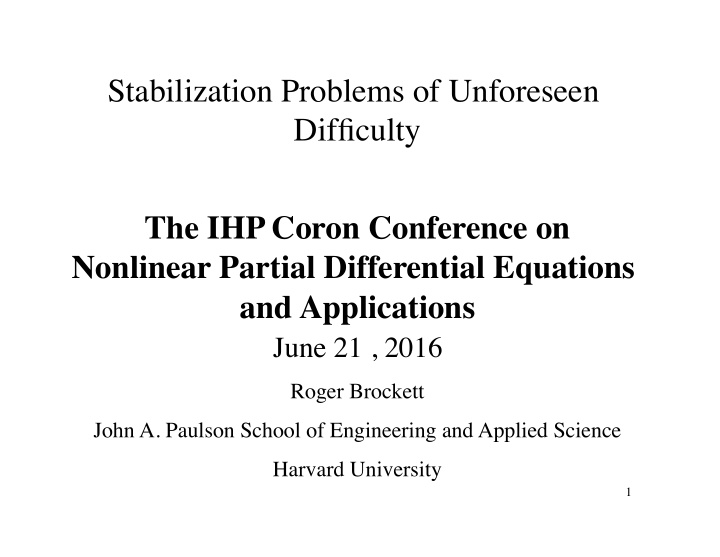



Stabilization Problems of Unforeseen Difficulty The IHP Coron Conference on Nonlinear Partial Differential Equations and Applications � June 21 , 2016 Roger Brockett John A. Paulson School of Engineering and Applied Science Harvard University 1
We are here to honor Jean-Michel Let the festivities continue with a little WHOOP DE DOO on feedback stabilization!
A little dictum from many years ago As a fourth year college student I took a course called “Scientific Writing”. For the most part this consisted of submitting essays and receiving criticism in response However the professor did insist on one general principle. It takes the form of something like a contract between the author and the reader and I will try to observe it today. Here it is: Never overestimate the prior knowledge of the reader and never underestimate the reader’s willingness to follow a logical argument. Shall I explain whoop de doo?
Sufficient conditions for the existence of a continuous, autonomous, stabilizing control There are several versions depending on the type of feedback allowed and the type of stability of interest. Here we discuss the existence and construction of continuous, time invariant feedback control giving rise to (local) asymptotic stability. This is the only problem I intend to talk about!
Notation
Many questions, and a few answers 1. Is there an algorithmic approach to finding a stabilizing control ? 2. Can known topological conditions such as, the index of a fixed point, etc. be extended in the direction of the Routh-Hurwitz test? 3. Can the connection with optimal regulation be made more useful? 4. Does there exist a useful classification in terms of normal forms? 5. What is the best rate of convergence in a given setting, 1/t, etc. ? 6. Assuming asymptotic stability, polynomial Liapunov functions exist but what is the lowest degree possible? 7. Is there a way to make simulation decisive for convergence to 0, even for a single trajectory?
Some (now quite old) background
We do not wish to discuss linear or near linear cases
Restrict attention to the critical cases The control version of “critical” Critical cases for ODEs in the Russian literature of the 1950s
I will assume u(0)=0; this is not quite standard After choosing the constant we still have the problem of finding u.
“Obvious” possibilities for attacking the problem
Does Routh-Hurwitz help in this setting?
make coefficients positive .8 to -.8 13 period about 3.3 -.5 to .5
3 to -3 -2 to 2
15 to -15 -15 to 15 15
None of these work!
Optimal Regulation and Factorization Finding an invariant submanifold for the flow, which contains 0.
Difficulties Surprisingly (?), the optimal control is not continuous even though the description looks quite friendly.
Smooth solutions of the regulator problem
Organizing for a war of attrition
Focus on a more specific class of problems
How hard is it to find a suitable Liapunov function?
The multiplicity one case follows a known pattern Recall the Lur’e problem in feedback stability
The higher multiplicity situation The third order system requires two nonlinear terms but we will provide a “non Liapunov” aproach later.
Standard forms: The invariants of matrix pairs
Standard forms: B of rank one
What does the KYP lemma tell us? No restriction on the order but multiplicity <3
Stability preserving enlargements (SPE)
The Lemma in pictures x y r(x) nonnegative
Proof of Lemma part I
Proof of Lemma part II
Applying the lemma
Applying the lemma Building on the fact that the control u = x ( ˙ x + x ) stabilizes the null solution of x + ux = 0 we see that ¨ � d x + x ) x 2 = 0) = 0 dt + x 2 � (¨ x + ( ˙ has a asymptotically stable null solution and takes the form x (3) + 2 x 2 ¨ x + 3 x 2 + x 4 ) ˙ x + x 5 = 0 x + (2 x ˙ Theorem: for any k ≥ 2 the null solution of x ( k ) + ux = 0 can be stabilized by a polynomial feedback Law.
Summary
Power law solutions provide insight on scale Example of a homogenous equation of weight = -2.
A numerical solution of
Observe that one can give this an algebraic flavor
Recall the index calculation
Many questions, and a few answers 1. Is there an algorithmic approach to finding a stabilizing control ? 2. Can known topological conditions such as, the index of a fixed point, etc. be extended in the direction of the Routh-Hurwitz test? 3. Can the connection with optimal regulation be made more useful? 4. Does there exist a useful classification in terms of normal forms? 5. What is the best rate of convergence in a given setting, 1/t, etc. ? 6. Assuming asymptotic stability, polynomial Liapunov functions exist but what is the lowest degree possible? 7. Is there a way to make simulation decisive for convergence to 0, even for a single trajectory?
Jean-Michel Congratulations on your many achievements! Best wishes for the years ahead!
Recommend
More recommend